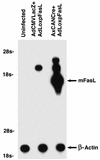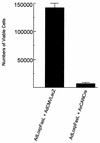Application of a Fas ligand encoding a recombinant adenovirus vector for prolongation of transgene expression
- PMID: 9499110
- PMCID: PMC109549
- DOI: 10.1128/JVI.72.3.2483-2490.1998
Application of a Fas ligand encoding a recombinant adenovirus vector for prolongation of transgene expression
Abstract
An adenovirus vector encoding murine Fas ligand (mFasL) under an inducible control was derived. In vivo ectopic expression of mFasL in murine livers induced an inflammatory cellular infiltration. Furthermore, ectopic expression of mFasL by myocytes did not allow prolonged vector-mediated transgene expression. Thus, ectopic expression of functional mFasL in vector-transduced cells does not appear to confer, by itself, an immunoprivileged site sufficient to mitigate adenovirus vector immunogenicity.
Figures








Similar articles
-
Induction of specific T-cell tolerance by adenovirus-transfected, Fas ligand-producing antigen presenting cells.Nat Biotechnol. 1998 Nov;16(11):1045-9. doi: 10.1038/3488. Nat Biotechnol. 1998. PMID: 9831033
-
Fas-Fas ligand interactions play a major role in effector functions of cytotoxic T lymphocytes after adenovirus vector-mediated gene transfer.Hum Gene Ther. 1999 Jan 20;10(2):259-69. doi: 10.1089/10430349950019048. Hum Gene Ther. 1999. PMID: 10022550
-
Adenoviral vector-mediated gene therapy in the mouse lung: no role of Fas-Fas ligand interactions for elimination of transgene expression in bronchioepithelial cells.Hum Gene Ther. 1999 Nov 20;10(17):2839-46. doi: 10.1089/10430349950016564. Hum Gene Ther. 1999. PMID: 10584929
-
Long-lasting adenovirus transgene expression in mice through neonatal intrathymic tolerance induction without the use of immunosuppression.J Virol. 1997 Jul;71(7):5330-5. doi: 10.1128/JVI.71.7.5330-5335.1997. J Virol. 1997. PMID: 9188602 Free PMC article.
-
Adenovirus: the first effective in vivo gene delivery vector.Hum Gene Ther. 2014 Jan;25(1):3-11. doi: 10.1089/hum.2013.2527. Hum Gene Ther. 2014. PMID: 24444179 Free PMC article. Review. No abstract available.
Cited by
-
Efficient gene activation in cultured mammalian cells mediated by FLP recombinase-expressing recombinant adenovirus.Nucleic Acids Res. 2001 Apr 1;29(7):E40. doi: 10.1093/nar/29.7.e40. Nucleic Acids Res. 2001. PMID: 11266575 Free PMC article.
-
Conditional gene expression systems to study herpesvirus biology in vivo.Med Microbiol Immunol. 2008 Jun;197(2):269-76. doi: 10.1007/s00430-008-0086-1. Epub 2008 Mar 7. Med Microbiol Immunol. 2008. PMID: 18324415 Review.
-
Specific deletion of autoreactive T cells by adenovirus-transfected, Fas ligand-producing antigen-presenting cells.Immunol Res. 2002;26(1-3):235-46. doi: 10.1385/ir:26:1-3:235. Immunol Res. 2002. PMID: 12403361 Review.
-
Inflammation, apoptosis, and necrosis induced by neoadjuvant fas ligand gene therapy improves survival of dogs with spontaneous bone cancer.Mol Ther. 2012 Dec;20(12):2234-43. doi: 10.1038/mt.2012.149. Epub 2012 Jul 31. Mol Ther. 2012. PMID: 22850679 Free PMC article.
-
Antigen presenting cells expressing Fas ligand down-modulate chronic inflammatory disease in Fas ligand-deficient mice.J Clin Invest. 2000 Mar;105(6):813-21. doi: 10.1172/JCI8236. J Clin Invest. 2000. PMID: 10727450 Free PMC article.
References
-
- Acsadi G, Lochmuller H, Jani A, Huard J, Massie B, Prescott S, Simoneau M P B, Karpati G. Dystrophin expression in muscles of mdx mice after adenovirus-mediated in vivo gene transfer. Hum Gene Ther. 1996;7:129–140. - PubMed
-
- Acsadi G, Massie B, Jani A. Adenovirus-mediated gene transfer into striated muscles. J Mol Med. 1995;73:165–180. - PubMed
Publication types
MeSH terms
Substances
Grants and funding
LinkOut - more resources
Full Text Sources
Other Literature Sources
Research Materials
Miscellaneous

